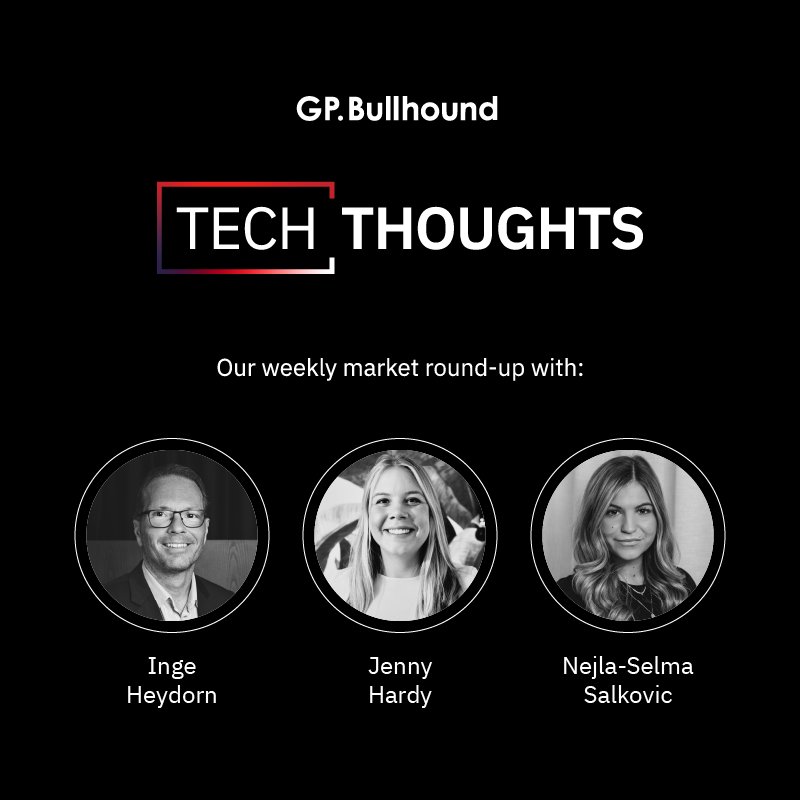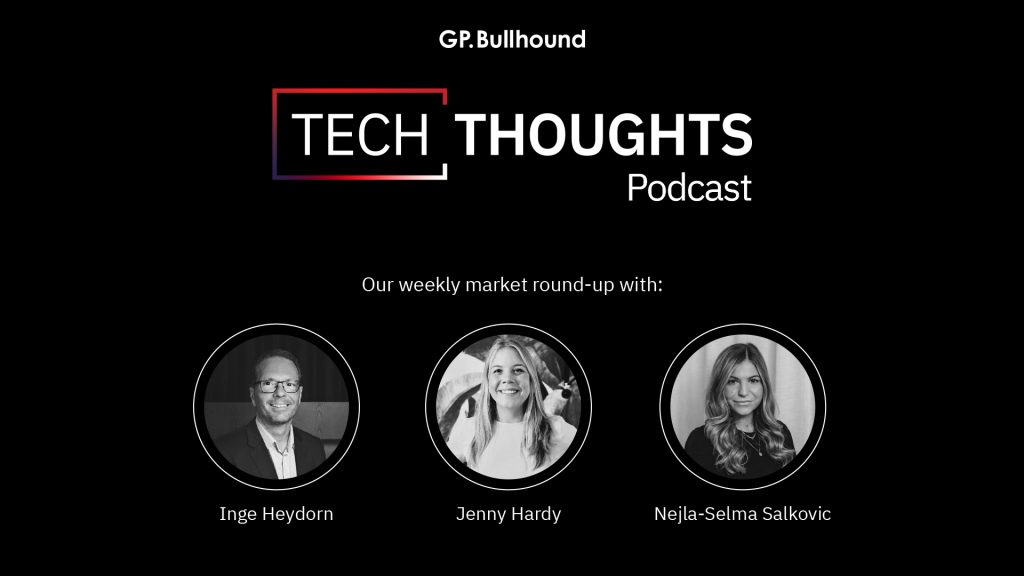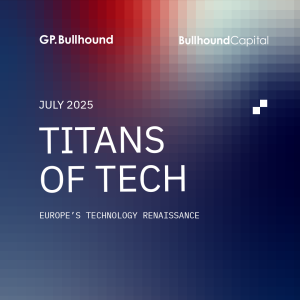Tech Thoughts Newsletter – 11 August 2023.

Market: the market continues to be volatile, on broadly lower volumes. The macro data is still mixed – China data released this week showed exports falling for a third consecutive month, which was followed by China officially falling into deflation as consumer and producer prices both dropped in July. Now the market is waiting to see what stimulus plans may emerge there. US inflation data was better (lower) than expectations, which helped stocks and tech into the end of the week.
Portfolio: we made no major changes to the portfolio this week.
AI arms race continues – Nvidia still gated by supply
- Nvidia’s CEO presented at SIGGRAPH 2023 with a slew of new product announcements, the most notable being its new GH200 Grace Hopper Superchip Platform. It combines two Grace Hopper chips interconnected with NVLink and equipped with 141GB of the latest HBM3e memory, 3.5x more memory capacity and 3x more bandwidth than the prior version. It is expected that servers using GH200 chips will be made available in Q2 2024.
- AMD’s new AI products (MI300) released this year particularly target more in-chip memory so Nvidia is being quick to respond to any potential technology advantage that might bring.
- Nvidia also announced Workstation GPU solutions which allow pre-trained AI models on PCs to scale up to cloud platforms.
- At the event, Microsoft also announced the availability of H100 Tensor Core GPU instances, using Nvidia H100 GPU and Nvidia’s Infiniband technology.
- Super Micro – a leading server business – provided commentary around the hyperscaler and AI ramp which supports the now well-understood view that Nvidia is sold out into the year’s end.
- Super Micro’s results have been hampered by continued component shortages for the last several quarters – with now the most significant issue clearly the Nvidia shortages: “We talk to them every day asking for more. Hopefully, their capacity grows.”
- With record backlog, it is clear that the underlying demand for their products – including those related to AI – is strong, with backlog at record levels entering a seasonally strong June quarter, and expecting strong September/December quarters.
Portfolio view: we’ve commented before that it’s Nvidia’s ecosystem (which speaks to the breadth of announcements this week) across AI which forms a key part of its competitive moat. To the extent which it is following AMD’s memory expansion could be seen as a positive affirmation of AMD’s MI300 product. We own both Nvidia and AMD and see them as seeing the bulk of the accrued value in the short term from AI. We believe supply remains the key gating factor for Nvidia, and to the extent that AMD can launch a competitive solution whilst Nvidia is supply-constrained will be positive for establishing it as a credible alternative.
Smartphone inventory correction continuing into year-end
- Global Foundries reported decent results, but pointed to Q3 below consensus given the continued inventory correction in particular across mobile, comms and datacentre and low-end consumer and home electronics – “inventory levels across several end markets are coming down more slowly than previously expected…and lower yr/yr demand”. And as we heard from players last week, it sounds like this is expected to last through the year.
- Positively, they still spoke of “solid” pricing and customers continuing to sign long-term supply agreements. On LTAs: “I think you see it in our performance, both in revenue and profitability that we’ve been able to manage inventory and manage underutilisation fees in a very pragmatic way…I dare to imagine what our world would look like if we didn’t have those partnership agreements in place in the downturn.”
- Auto remained a stronger growth segment for them, reflecting what we’ve heard elsewhere.
- Skyworks was more of the same in a broadly weak report (Apple and Android both down for them yr/yr) – although (a bit different from what we’ve heard elsewhere) they did point to China “starting to turn up”.
- Sony’s (owned) positive gaming release (further comments below) was somewhat overshadowed by a weaker smartphone outlook in its camera sensor business – particularly calling out a “delayed recovery” in China, a “prolonged slump” in Europe and a slowdown in the US, now saying the market was unlikely to recover before next year.
Portfolio view: there are few signs of life in the smartphone space and it continues to be an area we try to avoid direct exposure to. We do own Sony, where we see positive offsets elsewhere in its gaming business (comments below).
Memory likely first in semis to see a recovery
- The Semiconductor Industry Association announced June semis sales that were up 15% mth/mth (though still down 8% yr/yr), higher than the usual seasonality, predominantly driven by better memory sales and pricing.
- DRAM sales were up 55% mth/mth and ASPs were down just 2% mth/mth, better than usual seasonality; and Flash sales were up 40% mth/mth, with ASPs under a bit more pressure – down 4%.
- We commented last month on the statements from memory players SK Hynix and Samsung that were pointing to an inflection, partially driven by HBM AI demand.
Portfolio view: as we said last week there’s no doubt that ex-AI and auto, semis are taking longer to recover than we might have expected at the start of the year. It does seem that we will likely come out of the memory cycle the soonest (possibly this H2) – memory cycles can often be different to the broader semis cycle given the commodity nature and the price elasticity. This memory down cycle, which started in the middle of 2022, has been particularly brutal.
We don’t invest in memory players – while we do believe that the build-out of generative AI infrastructure will result in meaningful bit growth for the memory industry as a result of the DRAM content growth per server (and increased technical features around bandwidth and transfer rates), the reality is that the industry relies on rational supply. While Hynix and Samsung both spent their conference calls arguing for tech leadership in DRAM, ultimately the three players have always ended up with broadly the same tech, which means that rational supply can very easily break down, and has always struggled to make a sustainable return – just as we’ve seen over the past several quarters in the industry with the negative impact on pricing.
We do think we should benefit from any memory recovery and the related bit growth through our semicap equipment exposure – any stabilisation in DRAM ASPs is positive – and areas like HBM require new higher-end process tools given the increased technical requirements (see also Veeco comments below).
Positive signs in Semicap orders
- Lasertec (semicap equipment – in particular part of the EUV value chain) had pre-released its full year last month but the full details were better than expected with orders rebounding back to 58 billion yen, after the prior two quarters were in the low 30bns.
- Veeco (which makes thin film process equipment for semicap manufacturing) reported a strong beat in the June quarter and spoke to strong growth from orders related to high bandwidth memory (likely Hynix). They estimate that currently, ~10% of their revenue is attributable to AI, via GPU chip exposure and HBM DRAM. As we heard from other semicap equipment names this quarter, China was a strong driver of demand.
- Tokyo Electron reported in-line results and kept its full-year guide. The details were more of the same: China driving demand and HBM memory queries picking up.
- Nikon had a very weak set of results and reduced its full-year precision equipment profit outlook by 20%, hurt by lower utilisation of its lithography systems, we assume at Intel, where we think it’s being hurt by shifting budgets towards EUV. We’ve commented before on how behind Intel is in its EUV installations, and the degree of catch-up required – that will see sales shift from legacy lithography systems to ASML’s EUV machines.
Portfolio view: semicap remains a key exposure for us (we own ASML, LAM Research, KLA and Applied Materials). The resilience of the space amid the recent downturn in memory and weakness in logic is something we view as attractive, and we expect multiple structural drivers (geopolitics – see Germany subsidy news below, tech leadership and China trailing edge demand) to support growth into 2024/2025. The recent results point to a shallower trough than prior cycles, which we may now be through.
Germany’s semiconductor subsidies continue with auto-focused fab
- TSMC, Bosch, Infineon and NXP announced in a joint statement that they would build a €10bn fab in Dresden, Germany. The fab will be 70% owned by TSMC, with Infineon, NXP and Bosch each owning a 10% equity stake.
- The fab will start to be constructed in H2 2024 and is targeted to begin production by the end of 2027 – it will provide trailing edge chips specifically for the auto and industrial sector, which makes sense as the part of the market where there is a structural supply/demand gap.
- It’s rumoured the German government will provide €5bn in subsidies. TSMC has stated it will invest €3.5bn which leaves €0.5bn each for Infineon, NXP and Bosch.
Portfolio view: Governments around the world seem to have decided to build and subsidise local fabs is a good idea, with Germany particularly active over the past year or so (it is also subsidising a leading-edge fab for Intel). We think this fab – specifically trailing edge nodes serving the auto space, makes much more sense than Intel’s leading-edge fab. Europe clearly has a very large auto export industry, and trailing edge auto chips will continue to face a structural shortage as a result of the increased semis content in the move to EV (which is why we own Infineon and NXP).
More localised fabs should benefit semicap equipment names’ order books this year
Semis and geopolitics continue to be intertwined. More localised fabs ultimately means more semicap equipment and it remains one of the drivers of our above consensus view on the space.
In general a tough week in software reporting, with guidance mostly disappointing expectations
- Datadog reported results and lowered guidance that shows it’s still being hurt by cloud spend optimisations, with the main issue being fewer expansions from existing customers (quarterly NRR fell below 120%). While cloud results over the last couple of weeks (Microsoft, AWS, Google) pointed to an end in the optimisation spend, that doesn’t seem to be at all what Datadog is seeing – “customers, particularly some larger spending customers, scrutinise cost and optimise their cloud and observability usage”.
- Datadog did say though that there were “signs that cloud optimisation may start to subside” with the customer cohort who began optimising a year ago now stabilising.
- Five9 spoke to an installed base “still challenged by macro”, with particularly the consumer vertical facing the strongest headwinds.
- Teradata issued “ok” results and spoke to a macro environment that “seems to be stabilising, but can still be very volatile with companies continuing to scrutinise their spend closely”.
- The bright spot of software was cyber security with Cyberark reporting better-than-expected results and upgrading its outlook.
Portfolio view: We don’t own any of these software businesses, which all fall into the too expensive, with too uncertain a path to profitability bucket for now. Consumption business models (like Datadog) still haven’t really been through a cycle, and it’s clear that more broadly customers continue to scrutinise spend. More broadly for software it feels like though we may now be close to a trough in terms of budget optimisation, the shape of the recovery looks uncertain. Possibly most significantly, the high valuations create a lot of volatility in the shares, even with what were fairly “in line” results: Datadog -17%, Teradata -17%, Five9 -14%. We continue to be cautious around these.
Taiwanese monthly numbers coming in ahead of usual seasonality – catch up from June
- TSMC July sales were up 14% mth/mth – slightly better than the usual seasonality and making up for a somewhat weaker June (likely catch up from the iPhone 15 June production delay – same for Hon Hai below).
- Hon Hai reported sales up 11% mth/mth and flat yr/yr – in line with expectations around the new Apple products ramping. Separately there were rumours this week that the launch date for Apple’s iPhone 15, 15 Plus, Pro and Max will be September 13th. The expectation is for the standard models to have the A16 chip (which featured in iPhone 14 Pro and Pro Max and used TSMC’s 4nm node) while the flagship Pro will have the new A17 chip manufactured at TSMC’s 3nm node.
- UMC reported flat month-on-month numbers – the third stable month. Yr/yr revenues are still down 23% but it at least isn’t getting any worse.
Portfolio view: Stabilisation is good news, particularly amidst the very weak smartphone end demand. We still think TSMC 5nm capacity will be filled by Nvidia H100 demand, as Apple shifts from 5nm to 3nm for its A17 chip. We still think China’s sell-through for the iPhone is declining to a high single digit, and similar for Android.
Disney results are mixed – streaming still searching for a path to profitability
- Disney reported Q3 revenue relatively in line and a slight earnings beat.
- The negatives were that Disney+ Hotstar’s subscribers came in well below street estimates (after it lost the rights to Indian Premier League Cricket), which brought overall subscriber levels down again
- That is quite a big issue because that very large content cost Disney is spending needs to be amortised over a larger subscriber base to make the maths around the streaming business work
- While DTC losses narrowed there are clearly still question marks around the path to sustainable profitability in the business. Streaming still feels like a really tough business, and it’s hard not to view the presence of Amazon, Apple, YouTube as the big behemoths (who don’t necessarily need to make profits in that category) as a very big negative to the path to profitability and the sustainable level of profitability.
- We’ve spoken before that we might prefer Disney to focus on its differentiated (predominantly Disney) content, or even take the Sony approach and be a content seller. Iger seems to be taking a step in that direction as it took $2.65bn one-time charges, the majority of which were “content impairments” related to pulling content off its streaming platforms and ending third-party license agreements.
- The same day as the release, Disney announced price increases across its Disney+ subscription services – that’s one lever which without subscriber increases, it will need to keep pulling.
Portfolio view: we no longer hold Disney, having sold the last bit of our holding earlier this year (we started to heavily reduce positions after their October results last year). Broadly we question the long-term returns within the streaming sector – and Disney still wonders what Iger can do in terms of a strategy pivot and more cost-cutting.
Gaming strength continues in June
- NPD/Circana gaming numbers for June were the second highest ever June sales number, continuing the strength we saw in May.
- The best-selling game was Activision’s Diablo 4, followed by Final Fantasy XVI and Street Fighter 6. Nintendo’s Legend of Zelda dropped to 4th place.
- Sony (owned) raised its forecast for the current fiscal year, predominantly driven by its Games and Network Services Segment and the strong Playstation 5 performance, which as we’ve commented before (and remained the best seller in the June Circana release) is the strongest selling US console this year and calling out an increase in non-first party titles and add-on content.
- Take-Two reported slightly damp results but more important was management commentary reiterating its FY2024 guide and highlighting a strong 2025 and a significant uplift in bookings: “We continue to believe that we are positioning our business for a significant inflexion point in fiscal 2025 that will culminate in us delivering new record levels of operating performance next year and beyond,” which drove expectations that GTA 6 will likely release in 2024.
Portfolio view: We own Sony, and the report is also good news for AMD being the sole supplier of the processor, now through the 2020 supply issues. June 2023 data gives some reassurance that we may be through the Covid hangover for the gaming market.

For weekly insights on the latest market updates, please subscribe to our Tech Thoughts podcast.
For more information about the latest trends and forecasts, please visit our official Tech Thoughts page.
We provide investors with access to category leading technology companies, globally. Our assets under management have a total value of more than $1bn, and our limited partners include institutions, family offices and entrepreneurs. Learn more about our funds here.
Enquiries
For enquiries, please contact:
Inge Heydorn, Partner, at inge.heydorn@gpbullhound.com
Jenny Hardy, Portfolio Manager, at jenny.hardy@gpbullhound.com
Nejla-Selma Salkovic, Analyst, at nejla-selma.salkovic@gpbullhound.com
About GP Bullhound
GP Bullhound is a leading technology advisory and investment firm, providing transaction advice and capital to the world’s best entrepreneurs and founders. Founded in 1999 in London and Menlo Park, the firm today has 14 offices spanning Europe, the US and Asia.



